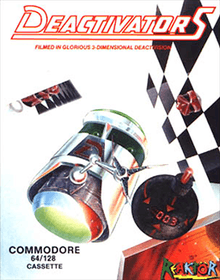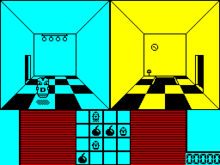Deactivators
| Deactivators | |
|---|---|
 Cover art | |
| Developer(s) | Tigress Marketing |
| Publisher(s) | Ariolasoft |
| Designer(s) |
David Bishop Chris Palmer |
| Programmer(s) | System Software |
| Platform(s) | Amstrad CPC 464, Commodore 64, ZX Spectrum |
| Release | 6 October 1986 |
| Genre(s) | Puzzle |
| Mode(s) | Single-player |
Deactivators is a action puzzle video game. It was designed by David Bishop and Chris Palmer, developed by Tigress Marketing, and published by Ariolasoft's label, Reaktor. It was released for the Amstrad CPC 464, Commodore 64, and ZX Spectrum in October 1986. The player controls bomb disposal robots known as Deactivators and must use them to deactivate bombs in five research complexes planted by terrorists. The concept for the game came from a brainstorming session between Bishop and Palmer, with its design and development taking five to six month to complete.
Deactivators received positive reviews from video game critics, and it was later ranked as one of the best games for the ZX Spectrum by Your Sinclair. Despite the positive reception, the game was not commercially successful and Tigress Marketing closed shortly after its release.
Gameplay

Deactivators is an action puzzle video game. The player controls bomb disposal robots, known as Deactivators, who must deactivate bombs placed throughout five scientific research complexes by terrorists. A time limit is set based on the fuses of the bombs. Picking up a bomb displays the fuse burning.[1] Disposal of the bombs requires the player to throw them from room to room to another Deactviator until they can be thrown out the exit. Security droids reprogrammed by the terrorists serve as obstacles that can destroy the Deactivators. If a bomb goes off in a room then everything inside of it gets destroyed.[2] The player can get new Deactivators after completing a building.[3]
Four different commands can be used in the game: Selecting Deactivators droids to control, moving the droids, having the droids throw, and scanning all the rooms in the building.[3] Each room has different gravity and perspectives, with some rooms being sideways or upside-down.[4][5] There are also circuit boards that must be inserted into a computer to activate functions such as opening a door or window, deactivating force fields, or turning on teleporters.[2][6] The game also includes a level editor, allowing the player to create their own rooms.[7]
Development
Deactivators was designed by David Bishop and Chris Palmer. Bishop was the co-founder of Tigress Marketing, the developers of the game, with Palmer having joined Tigress after leaving Argus Specialist Publications. The conception of the game stemmed from a brainstorming session between Bishop and Palmer for game ideas. The design was done by hand and paper to work out the tasks in each building, as well as the timing and routes required to complete them. The design process took a month to complete, with development taking four or five months.[8] The programming for the game was done by System Software and was published by Ariolasoft under its Reaktor label, created to focus on arcade and action games for Ariolasoft.[8][9] It was released on 6 October 1986 for the Amstrad CPC 464, Commodore 64, and ZX Spectrum.[8][10]
Reception
| Reception | ||||||||||||||||
|---|---|---|---|---|---|---|---|---|---|---|---|---|---|---|---|---|
| ||||||||||||||||
Deactivators received generally positive reviews from video game critics. The ZX Spectrum version was ranked number 28 in the Your Sinclair "Official Top 100 Games of All Time".[13] A reviewer for Computer and Video Games opined that the game was destined to become a cult game.[3] Andrew Wilton from Amstrad Action praised its gameplay, describing it as "excellent," noting the room perspective changes as the most interesting feature in the game.[5] Sinclair User's Taylor Graham compared it favorably to 1984's Spy vs. Spy.[6]
The graphics received mixed reactions for each console. Crash and Your Sinclair spoke positively of the Spectrum's graphics. The Crash reviewer praised the details and animations of the droids, along with the design of the rooms,[2] while Gwyn from Your Sinclair described the graphics as "clean".[11] Andrew Wilton marked it as the most disappointing part of the game for not using the most of Amstrad's colour limitations.[5] The Commodore 64 graphics were also well received by Zzap!64, who noted the monochromatic appearance to be "unusual, but effective".[12] The Computer and Video Games reviewer praised the Commodore 64 version for its sound over the Amstrad and Spectrum versions.[3]
Despite being well received from critics, the game was not commercially successful. In an interview with Retro Gamer about the game, Chris Palmer believed there was a disconnect between the marketing for the game and what it was actually about. Shortly after Deactivators's release, developer Tigress Marketing closed, after Ariolasoft, the majority publisher for Tigress, left software publishing. David Bishop went on to continue game designing, later working for Virgin Interactive, Mindscape and PopCap Games. Palmer left the video games industry to work in Information technology.[8]
References
- ↑ Deactivators instructions. Ariolasoft. 1986.
- 1 2 3 4 "Deactivators". Crash. No. 34. November 1986. p. 138.
- 1 2 3 4 5 Metcalfe, Tim (November 1986). "C+VG Nov Software Reviews – Deactivators". Computer and Video Games. No. 61. Future plc. p. 61.
- ↑ "Preview". Crash. No. 32. September 1986. p. 92.
- 1 2 3 4 Wilton, Andrew (November 1986). "Action Test". Amstrad Action. No. 14. Future plc. pp. 46–47.
- 1 2 3 Taylor, Graham (October 1986). "Arcade Review – Deactivators". Sinclair User. No. 55. p. 37.
- ↑ "News". Computer and Video Games. No. 60. Future plc. October 1986. p. 13.
- 1 2 3 4 Mason, Graeme (2013). "The Making of: Deactivators" (PDF). Retro Gamer. No. 119. Imagine Publishing. pp. 46–47.
- ↑ "Branching Out..." ZX Computing Monthly. No. 30. October 1986. p. 7.
- ↑ "Droids are Deactivators". Sinclair User. No. 54. September 1986. p. 92.
- 1 2 Gwyn (June 1987). "Screen Shots". Your Sinclair. No. 18. Dennis Publishing. p. 44.
- 1 2 "Zzap Test – Deactivators". Zzap!64. No. 19. November 1986. p. 116-117.
- ↑ "Let the People Decide! The Results!". Your Sinclair. No. 93. Dennis Publishing. September 1993. p. 11.
External links
- Deactivators at SpectrumComputing.co.uk
- Deactivators at Lemon 64
- Deactivators can be played for free in the browser at the Internet Archive